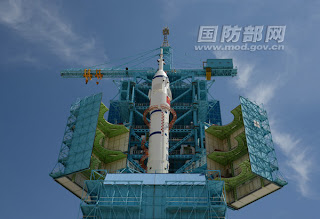In foreground, Tiangong 1 station obscures the Shenzhou-9 Spacecraft. Credit CCTV.
The Chinese space program completed a major step in their efforts to rival the USA and USSR in space achievements this weekend. It began with the launch of a Long March 2f rocket from the Jiuquan Space Center in the Gansu Province. The Saturday launch in the Shenzhou-9 spacecraft immediately achieved another first for China, as the three-taikonaut crew carried the first Chinese woman to orbit.
Long March rocket roll-out to the pad. Credit: CCTV.
The Long March is carried to the pad by a large crawler, while the crowd gets a great close up view.
Credit: CCTV
Long March at gantry, as support scaffolding moves to embrace it. Chinese Shenzou spacecraft follow Russian Soyuz design, but launch facilities seem to follow Western concepts. Credit: CCTV
Blast off! Credit China Academy of Launch Technology.
After the liftoff on Saturday, the Shenzhou-9 carried the crew to rendezvous with the Tiangong-1 Orbital Module. Previously, an unmanned Shenzhou spacecraft had been remotely piloted to the station and ground controllers had practiced docking procedures. Now, early on Monday morning, the spacecraft docked with a crew of three: Commander Jing Haipeng opened the hatch a few hours later, and was followed inside by Liu Wang.
Inside the module. Hatch opens and Jing Haipeng, on his second spaceflight, waves to the camera. Credit: CCTV
Jing Haipeng approaches the camera while Liu Wang enters the hatch in background.
Admittedly, the interior of the module seems spartan and empty compared to the packed but roomy ISS modules or the often cluttered Russian space stations of the past. Of course the camera lens is allowing a wider view which makes it look a little wider than it actually is, but it still looks nice and orderly in there. Well, let's see how it looks as they get used to working in the module. Meanwhile, China's first woman in space, Liu Yang, remained in the Shenzhou-9 to monitor operations while the module base was established. Eventually she also made her way into the Tiangong-1.
Liu Yang in the cramped Shenzhou cabin. Now, THIS looks more like a Soyuz... Credit:CCTV
The Shenzhou-9 crew inside Tiangong-1, sending greetings to Earth.
Credit is given where credit is due, and the Chinese have certainly performed a great feat in their space efforts with this mission. The people of China must certainly be proud of their accomplishments, and all space buffs are happy to cheer them on and wish them a successful mission. One thing for certain. their TV transmissions were better than the ones that came from the Russian Mir station... ; )







































